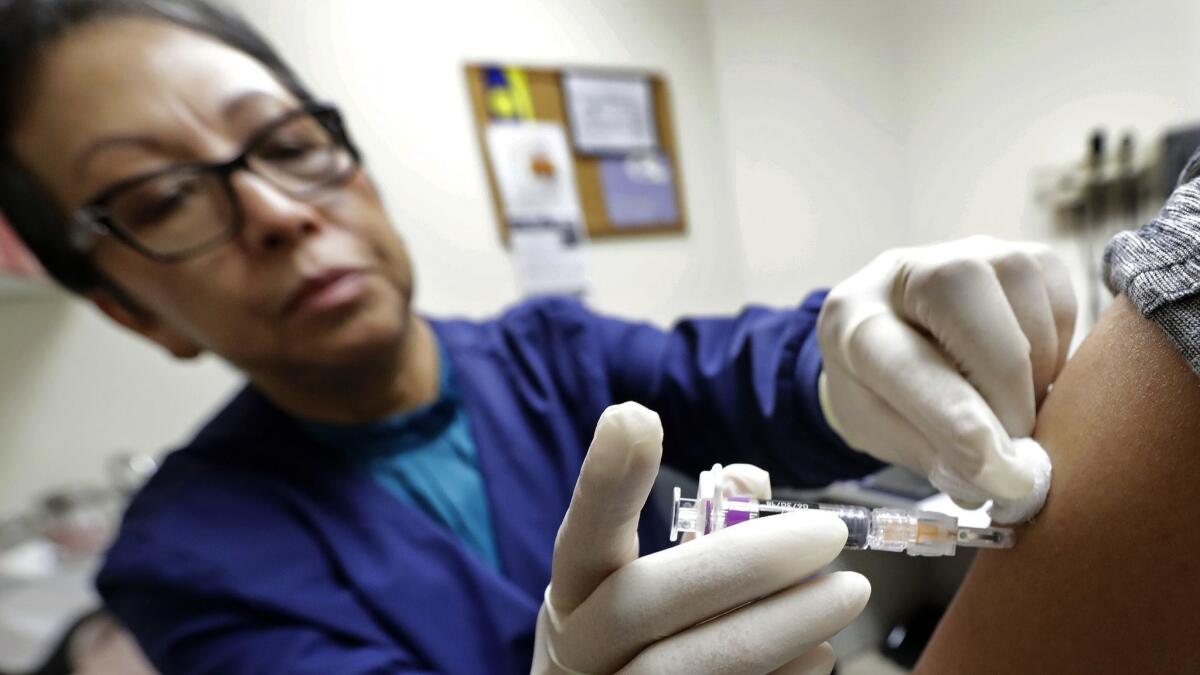Op-Ed: Save a grandma. Get your flu shot

A natural disaster is bearing down on our country, one assured to take the lives of thousands and hospitalize tens of thousands more: the annual flu epidemic. Last year’s strains were particularly virulent, with 900,000 Americans hospitalized and more than 80,000 people dying from the flu or its complications.
To make matters worse, many of these people died needlessly.
The flu vaccination rate in the United States hovers around 45%. If we could increase this rate to 70% — the level required to reach “community” or “herd” immunity and keep an epidemic from propagating — the majority of the deaths, hospitalizations and missed days of work could be avoided. But to do that, we need to properly incentivize vaccination.
Right now, if you’re a relatively healthy person, a flu shot might reduce your personal risk of coming down with the flu by 40% to 60%. But getting a flu shot also does something else: It helps protect the people around you who are most vulnerable to serious flu illness, particularly the very old and the very young. A vaccine that is 60% effective on a 30-year-old, for instance, may be only 30% effective on someone over 65. Babies are notably hospitalized for influenza at alarming rates.
A new study by Cal Poly Pomona economist Corey White has measured these powerful ripple effects of flu vaccination. Using 50-state data from 1994 to 2016, he estimates each percentage point increase in the U.S. vaccination rate would result in 807 fewer deaths. (Put another way, if an additional 4,016 people were vaccinated this season, we would expect to save one life.) These benefits accumulate incrementally until we reach the herd immunity threshold.
Most of those lives saved are of people over 75 ... so in the lingo of Twitter, young people should get the flu shot to #ProtectRBG.
Most of those lives saved are of people over 75. So if you want to save the lives of grandmothers and grandfathers in your community, get a flu shot. Or, in the lingo of Twitter, young people should get the flu shot to #ProtectRBG.
White found other positive community effects. A one percentage point increase in the vaccination rate would result in 15 million fewer lost work hours nationwide. That means that your failure to get a shot will, on average, cause five hours of wages to be lost.
Health agencies charged with promoting flu shots should be leveraging these community benefits in their campaigns. A recent study from the University of Minnesota found that a third of people didn’t know that getting a flu vaccine can help others not get sick; educating them about the benefits of herd immunity increased their willingness to get vaccinated by 7.3%.
If cajoling and appealing to altruism isn’t enough, we can do more. The broad population benefits of high flu vaccination rates make the case for what economists call a Pigovian subsidy. In other words, we should pay people to get vaccinated. By White’s estimate, each vaccination produces at least $98 in social benefits due to reduced work absences, substantially exceeding the $15 per-shot cost of administering a mass vaccination. How much would we have to pay people? A 2015 study by Swarthmore economists has found that a $30 subsidy was enough to increase vaccine rates by 12 percentage points — and White’s lost-work estimates suggest that a much larger carrot would be cost-justified.
Enter the Fray: First takes on the news of the minute from L.A. Times Opinion »
Large employers are a natural site for mass vaccinations, so one could imagine tax breaks for employers if their workforces reach a target vaccination rate. Or governments could experiment with a variety of financial carrots and sticks to find the mix that achieves community immunity without over-vaccinating to the point where benefits plateau.
Changing the nation’s flu shot habits will have another payoff. Sooner or later, a much more virulent strain will emerge — like the 1918 pandemic that claimed an estimated 675,000 lives just in the United States and more than 20 million worldwide. With the community protection of a much higher vaccination rate, another pandemic won’t be so disastrous.
We need not accept that tens of thousands of Americans die each year from influenza right now either. Through better evidence-based messaging and subsidies for flu shots, we can start saving lives (and hospitalizations and lost work days) today.
Ian Ayres is the Townsend Professor at Yale Law School and a co-founder of the commitment website, stickK.com.
Follow the Opinion section on Twitter @latimesopinionand Facebook
More to Read
A cure for the common opinion
Get thought-provoking perspectives with our weekly newsletter.
You may occasionally receive promotional content from the Los Angeles Times.










